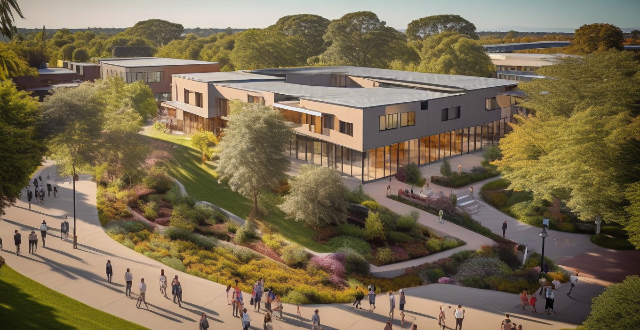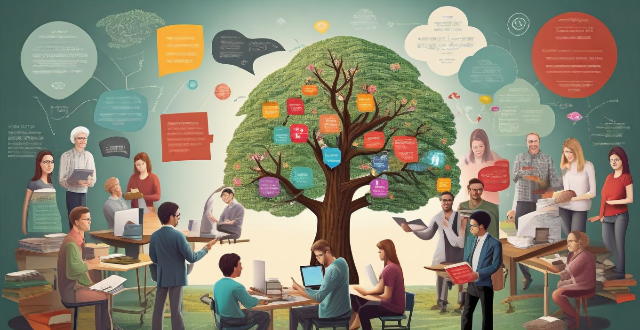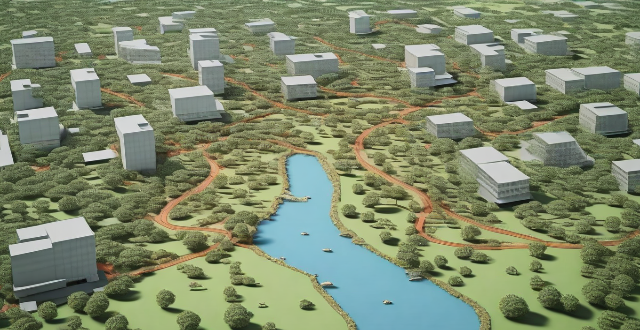Community Resilience

How can civil society organizations contribute to building resilience against climate conflicts ?
Civil society organizations (CSOs) are essential in building resilience against climate conflicts through advocacy, awareness-raising, capacity-building, and community-based adaptation. They advocate for policies that promote climate resilience, raise awareness about climate change impacts, build community capacity to cope with climate stressors, and support community-led adaptation initiatives. CSOs collaborate with various stakeholders to ensure climate change is addressed in national and international agendas, disseminate information on climate risks and adaptation strategies, provide technical assistance and resources for locally-led projects, and engage in livelihood diversification, food sovereignty, and ecosystem conservation efforts. By working together, CSOs contribute to a more equitable and sustainable future.

How can we build climate resilience in our communities ?
Climate resilience is essential for community sustainability and well-being. Building it involves education, sustainable infrastructure, ecosystem conservation, economic strategies, community engagement, and research. Efforts must be collective across all sectors to achieve a resilient and sustainable future.

What are the benefits of climate resilience ?
Climate resilience is crucial for adapting to climate change impacts and recovering from related damages. It offers economic, social, environmental, political, and cultural benefits. These include reduced damage costs, protection of assets, enhanced productivity, improved public health, community cohesion, continuous education, biodiversity conservation, resource stewardship, reduction of greenhouse gas emissions, increased government legitimacy, international leadership, policy innovation, preservation of heritage, strengthening of cultural practices, and promotion of cultural exchange. Building climate resilience ensures more robust, equitable, and sustainable futures.

How can businesses contribute to climate resilience ?
Climate resilience refers to the ability of a system, community, or society to withstand and recover from the impacts of climate change. Businesses have a significant role to play in building climate resilience. Here's how they can contribute: 1. Reducing Greenhouse Gas Emissions: Businesses can invest in energy-efficient technologies and practices to reduce their carbon footprint. They can also switch to renewable energy sources like solar, wind, or hydroelectric power to significantly reduce greenhouse gas emissions. 2. Sustainable Sourcing and Production: Businesses can ensure that their suppliers adhere to sustainable practices, reducing the environmental impact of their products. By using resources more efficiently and reducing waste, businesses can minimize their environmental footprint. 3. Investing in Research and Development: Businesses can invest in research and development of clean technologies that can replace fossil fuel-dependent processes. Encouraging innovation within the company can lead to new solutions for reducing environmental impact and increasing sustainability. 4. Adapting to Climate Change: Businesses can design and build infrastructure that is resistant to extreme weather events caused by climate change. Implementing efficient water management systems can help businesses adapt to changing water availability due to climate change. Diversifying supply chains can reduce the risk of disruptions caused by climate-related events. 5. Advocating for Climate Action: Businesses can use their influence to advocate for policies that support climate resilience and sustainability. Collaborating with other businesses, governments, and non-governmental organizations can amplify efforts to build climate resilience. Raising public awareness about climate change and its impacts can help create demand for more sustainable products and services. 6. Community Engagement and Support: Providing education and training on climate resilience can empower communities to adapt to changing climate conditions. Supporting disaster preparedness programs can help communities cope with climate-related emergencies. Partnering with local organizations can help businesses understand and address the specific challenges faced by their communities due to climate change.

How can we measure the effectiveness of climate resilience strategies ?
Measuring the effectiveness of climate resilience strategies is crucial for ensuring that communities and ecosystems are adequately prepared for the impacts of climate change. Key factors to consider when evaluating the success of these strategies include assessing impact reduction, monitoring adaptive capacity, evaluating systemic resilience, long-term sustainability, scalability and replication, and community engagement and perception. By considering these factors and using a combination of quantitative data analysis and qualitative assessments, we can comprehensively measure the effectiveness of climate resilience strategies. This will help in refining current approaches and informing future strategies to build a more resilient world in the face of ongoing climate change.

How does climate resilience relate to sustainable development ?
Climate resilience and sustainable development are interconnected concepts that aim to ensure the long-term well-being of our planet and its inhabitants. They share common goals, such as addressing global challenges like poverty, inequality, and environmental degradation by integrating short-term actions with long-term visions. Climate resilience refers to the ability of a system, community, or society to withstand and recover from the impacts of climate change, including extreme weather events such as hurricanes, floods, and droughts. It involves adapting to changing environmental conditions while maintaining essential functions and services. Key elements of climate resilience include adaptation, mitigation, preparedness, and recovery. Sustainable development is development that meets the needs of the present without compromising the ability of future generations to meet their own needs. It balances economic growth, social inclusion, and environmental protection for long-term prosperity. The three pillars of sustainable development are economic, social, and environmental. The intersection of climate resilience and sustainable development lies in their complementary goals, mutual benefits, integrated approaches, and policy coherence. Achieving climate resilience can support sustainable development by reducing vulnerabilities to climate change, which in turn can help maintain economic stability and protect livelihoods. Pursuing sustainable development can enhance climate resilience by promoting clean energy sources, efficient resource use, and robust ecosystems that can absorb the impacts of climate change. Integrating climate resilience into sustainable development strategies ensures that efforts to combat climate change are not isolated but rather part of a broader plan for sustainable living. This includes investing in renewable energy, building green infrastructure, and fostering sustainable agriculture practices. Governments and organizations must ensure policy coherence between climate action and sustainable development goals. By aligning policies, they can avoid conflicting objectives and maximize synergies between these two critical areas. In conclusion, climate resilience and sustainable development are not only compatible but also mutually reinforcing. Building resilience against climate change impacts is an integral part of achieving sustainability, just as pursuing sustainable pathways can strengthen our capacity to adapt and thrive in a changing climate. Together, they offer a comprehensive approach to securing a resilient and sustainable future for all.

How do ecosystem-based adaptation methods contribute to climate resilience ?
Ecosystem-based adaptation (EBA) methods play a crucial role in building climate resilience by leveraging the natural capacity of ecosystems to mitigate and adapt to the impacts of climate change. These approaches focus on conserving, restoring, and promoting sustainable management of ecosystems to provide essential services that help communities cope with climate-related stresses. Below are several ways EBA methods contribute to enhancing climate resilience: Protection from extreme events, enhancement of biodiversity, promotion of sustainable livelihoods, regulation of water resources, carbon sequestration and storage, community empowerment and education, disaster risk reduction, and research and innovation.

How can companies incorporate climate resilience into their workforce development strategies ?
Incorporating Climate Resilience into Workforce Development Strategies Climate resilience is essential for businesses to withstand and recover from climate-related stresses and shocks. Companies can build a resilient workforce by developing a climate resilience training program, integrating sustainability into company culture, enhancing adaptive capacity, building partnerships and collaborations, investing in technology and innovation, promoting health and well-being, and implementing resilience in operations. These strategies require a multifaceted approach that includes education, cultural integration, skill enhancement, partnerships, technological innovation, health promotion, and operational resilience. By taking these steps, companies can protect their business interests and contribute positively to the global effort in combating climate change.

How can we raise awareness about the importance of community climate adaptation ?
To raise awareness about the importance of community climate adaptation, several strategies can be employed: 1. **Education and Outreach Programs**: Conduct workshops, engage schools, collaborate with media outlets, and develop informational materials to educate people about climate change and its implications. 2. **Community Engagement Initiatives**: Encourage public participation in discussions, foster partnerships with local organizations, and promote civic leadership to drive climate adaptation efforts. 3. **Visual Aids and Creative Approaches**: Use art, performances, exhibits, infographics, and other creative means to communicate the importance of climate resilience. 4. **Online Platforms and Social Media**: Leverage digital tools like social media campaigns, online forums, virtual reality experiences, and interactive apps to reach a wider audience. 5. **Policy Advocacy and Support**: Advocate for favorable policies, provide financial incentives, and support legislation that enhances community resilience against climate change.

How can we measure the effectiveness of community climate adaptation efforts ?
Measuring the effectiveness of community climate adaptation efforts is crucial for understanding their impact on resilience to climate change. Key steps include setting clear objectives, developing relevant indicators, collecting and analyzing data, transparent reporting, evaluating success, iterative improvement, community engagement, and policy alignment. By following these steps, communities can ensure their adaptation efforts are effective and continuously improved.

What role do governments play in promoting climate resilience ?
Governments play a crucial role in promoting climate resilience. They can take various actions to mitigate the impacts of climate change and build resilience among their citizens. Here are some ways governments can promote climate resilience: 1. Enacting and Implementing Policies - Reducing greenhouse gas emissions - Protecting natural resources - Investing in infrastructure 2. Providing Financial Support - Funding research and development - Providing grants and loans - Creating incentives for businesses 3. Educating the Public - Raising awareness - Training professionals - Promoting behavior change 4. Collaborating with Other Stakeholders - Partnering with NGOs - Engaging with the private sector - Working with international organizations

What are some innovative examples of companies integrating climate resilience into their CSR frameworks ?
Incorporating climate resilience into corporate social responsibility frameworks is becoming increasingly important. Here are some innovative practices by companies like Unilever, Microsoft, Adidas, Tesla, and Patagonia to reduce environmental impact and build resilience against climate change effects.

How can immigrants effectively integrate into a new community ?
Effective integration of immigrants into a new community involves learning the local language, engaging with the community, embracing cultural differences, building a support network, seeking out resources, and being patient and persistent. These strategies can help immigrants communicate effectively, find employment opportunities, understand the culture, make friends, and navigate the legal processes involved in immigration.

How can we promote resilience in adolescents during their developmental years ?
The article discusses the importance of promoting resilience in adolescents to help them cope with various challenges during their developmental years. It suggests several strategies, including encouraging positive thinking, building problem-solving skills, promoting social support, encouraging participation in extracurricular activities, teaching emotion regulation skills, and promoting healthy lifestyle habits. These strategies can help adolescents develop the resilience they need to thrive during their developmental years.

What is climate resilience ?
Climate resilience is the ability of systems, communities, or societies to adapt to and recover from climate change impacts. It involves measures like infrastructure upgrades, renewable energy use, disaster risk reduction, and financial investment. Benefits include economic stability, public health improvement, ecosystem preservation, and social cohesion.

What role does discipline in sports play in achieving personal goals and mental resilience ?
The text discusses the importance of discipline in sports for achieving personal goals and building mental resilience. It outlines key aspects such as setting clear objectives, consistent practice, overcoming obstacles, self-regulation, focus and concentration, and resilience under pressure. The article emphasizes that discipline not only enhances physical performance but also strengthens mental fortitude, enabling athletes to reach their full potential and thrive in their respective sports.

What strategies can coaches use to foster resilience and mental toughness in their athletes ?
Strategies for Coaches to Foster Resilience and Mental Toughness in Athletes: Emphasize the Importance of Mindset: Encourage positive self-talk, visualization techniques, and goal setting. Build a Supportive Environment: Create an open communication environment, promote teamwork, and provide constructive feedback. Teach Coping Mechanisms: Introduce stress management techniques, problem-solving skills, and time management strategies. Incorporate Adversity Training: Simulate pressure situations, discuss overcoming setbacks, and incorporate physical challenges. Lead by Example: Model resilience, share personal experiences, and show a commitment to continuous learning.

How important is public awareness and education in the context of disaster risk management ?
Public awareness and education are vital in disaster risk management, enhancing community preparedness, reducing vulnerabilities, promoting resilience, and encouraging community engagement. Examples like Hurricane Katrina and the Japan Earthquake and Tsunami highlight the importance of these initiatives in saving lives and minimizing damages during disasters.

How can communities improve their resilience to climate change ?
Communities worldwide face challenges due to climate change, necessitating enhanced resilience. Key strategies include building awareness through education and training, upgrading infrastructure with sustainable solutions, conserving ecosystems, integrating climate considerations into planning, diversifying economies, and engaging communities in decision-making processes. These efforts not only help communities adapt but also contribute globally to combating climate change.

How can we adapt to the impacts of climate vulnerability ?
Adapting to the Impacts of Climate Vulnerability: This article discusses strategies to adapt to the impacts of climate change, including understanding risks, building resilience, enhancing community capacity, and long-term planning. It emphasizes the importance of assessing potential impacts on sectors such as agriculture, water resources, health, and infrastructure, and implementing both structural and non-structural measures to build resilience. The article also highlights the crucial role of communities in adaptation and the need for comprehensive adaptation plans that consider future scenarios and incorporate feedback mechanisms for continuous improvement.

How can we involve community members in climate adaptation planning ?
Community engagement is crucial for successful climate adaptation planning. To involve community members, identify and engage stakeholders, develop a stakeholder engagement plan, use multiple channels of communication, involve community members in decision making, provide training and education, foster partnerships and collaboration, and monitor and evaluate progress. By doing so, you can create a more resilient community that is better prepared for the impacts of climate change.

How can climate resilience help mitigate the impacts of climate change ?
Climate resilience is a crucial strategy for mitigating the effects of climate change. It involves reducing vulnerability, enhancing adaptive capacity, promoting sustainable development practices, and fostering social cohesion. By implementing these strategies, communities can become more resilient and better able to cope with the impacts of climate change.

How can communities improve their resilience against disasters ?
Communities can improve their resilience against disasters by focusing on education and awareness, infrastructure and building codes, emergency response plans, resource allocation, communication systems, and community participation. This includes conducting workshops, drills and simulations, reinforcing construction, retrofitting old structures, marking evacuation routes, preparing shelter spaces, stockpiling supplies, establishing alert systems, creating volunteer programs, and encouraging neighborhood watch groups.

How is climate resilience incorporated into modern urban development projects ?
Incorporating climate resilience into modern urban development projects is crucial for ensuring the sustainability and longevity of cities. Key strategies include sustainable transportation, green infrastructure, energy efficiency, water management, and community engagement and education. By implementing these measures, developers can build cities that are better equipped to adapt to the challenges posed by climate change, ensuring the long-term viability of our cities.

What are some examples of successful climate resilience initiatives ?
Successful climate resilience initiatives include green infrastructure development, community-based adaptation programs, disaster risk reduction plans, integrated coastal zone management, climate-smart agriculture, and climate change education and awareness campaigns. These strategies aim to prepare for, respond to, and recover from the impacts of climate change by building the capacity of communities, ecosystems, and countries to withstand and adapt to climate-related stresses and shocks.

How does extreme weather impact mental health ?
This comprehensive analysis discusses the impact of extreme weather events on mental health, highlighting immediate emotional responses, trauma, stress, long-term effects like PTSD and depression, community impact, and intervention strategies. It emphasizes the need for early intervention, community support, accessible resources, and resilience building to address these challenges effectively.

What role do community gardens play in city greening efforts ?
Community gardens play a significant role in city greening efforts by providing environmental, social, economic, and urban planning benefits. These gardens improve air quality, enhance biodiversity, and promote soil health. They also foster community building, offer educational opportunities, and contribute to health promotion. Economically, community gardens provide food security and create job opportunities. Integrated into urban planning, they beautify cities and promote sustainable development. Overall, community gardens are vital for ecological health and improving residents' quality of life.

How do sports events promote social interaction and community building ?
Sports events play a significant role in promoting social interaction and community building. They bring people together, foster a sense of belonging, and create opportunities for individuals to connect with one another. This is achieved through encouraging participation, building community spirit, providing entertainment and recreation, facilitating networking opportunities, and enhancing diversity and inclusion. By bringing people together around a shared passion for sports, these events create lasting connections and positive experiences that extend far beyond the playing field.

In what ways do women's empowerment initiatives contribute to community development ?
Women's empowerment initiatives are crucial for community development as they address gender inequalities and foster inclusivity. These initiatives benefit not only women but also have a positive ripple effect on the broader community, leading to more sustainable and equitable growth. Economic growth is achieved through increased participation in the workforce, entrepreneurship and innovation, and improved household economics. Social development is promoted through health and well-being, education, and gender equality. Political empowerment is enhanced through increased participation in decision-making and promotion of good governance. Environmental sustainability is ensured through resource management and climate action. Cultural preservation and exchange are enriched through artistic expression and cultural exchange. Women's empowerment initiatives are essential for comprehensive community development, addressing gender inequalities, promoting inclusivity, and paving the way for sustainable growth, social cohesion, and a brighter future for all members of the community.

What are the most effective strategies for community climate adaptation ?
Effective strategies for community climate adaptation include risk assessment and planning, infrastructure upgrades, sustainable land use practices, and education and awareness. These strategies aim to reduce vulnerability and enhance resilience to the impacts of climate change.